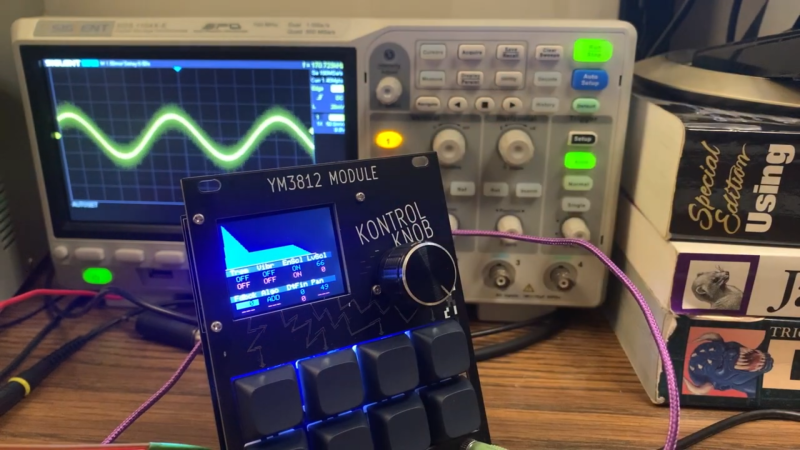One reason the x86 PC became the dominant game platform in the early 1990s was the availability of affordable sound cards like the AdLib and Sound Blaster. These provided a quantum leap in sound quality compared to the PC speaker’s tinny beeps, thanks to Yamaha’s YM3812 chip, also known as OPL2. [Tyler] has made a detailed study of the various OPL series chips and wrote a comprehensive guide describing their operation.
[Tyler] begins by explaining the theory of FM synthesis. The basic idea is that you generate sine waves of different frequencies, combine them through mixing and modulation, and then adjust their strength over time. This way, a few simple operations on the chip’s nine sound channels can generate an astonishing variety of sounds from clear notes to chaotic noise. He then delves into the details of the YM3812 chip, including its 279 different register settings that enable all these operations.
The final goal of [Tyler]’s research is the design of a YM3812 EuroRack module that fits inside standard modular synthesizers. He’ll go into detail on the board’s design and construction in future blog posts, but he already shows the finished product and demonstrates its features in the video embedded below. It’s a great introduction if you’re new to FM synthesis and want to recreate those magic DOS game sounds.
Of course, you can also just connect the OPL2 chip to your DOS computer, whether through a classic sound card or through a parallel port. The related YM2612 from the Sega Genesis also makes a fine synthesizer.















The YM3812 and YM2612 were venerable chips. I think it’s often overlooked just how extensive Yamaha’s lineup in terms of audio chips during the 80’s and 90’s were, and how they contributed not only to the sound of PC and console games in the early 90’s, but also arcades from the mid 80’s onward.
In addition to those two chips, Yamaha also had the YM2151 (OPM), which was used by arcade companies including Sega, Taito, Atari, and many others. Particularly with Atari, you couldn’t throw a rock without hitting a game of theirs that made use of the YM2151’s ability to produce a really convincing Rhodes Piano sound. They had the YM2203 (OPN), which combined a couple of FM channels alongside the functional equivalent of a General Instrument AY-3-8910 (or Yamaha’s YM2149). The YM3812 was preceded by the YM3526, the first in the OPL series, being sported by Taito’s “Bubble Bobble” alongside a YM2203.
The Yamaha YM2608 and YM2610 (OPNA and OPNB) followed on from the 2203, and were used in arcade machines where ADPCM playback was desired alongside the SSG channels and FM channels, most notably the Neo-Geo.
The more people have been digging into it, the more people have found – it’s turned out that Sega’s PCM-playback chip used in their mid-90’s lineup, previously called “MultiPCM” and assumed to be a custom Sega chip, is actually a licensed Yamaha YMW258 fore. There’s even some theorizing that the PCM chip they used in Outrun a decade earlier is also some licensed Yamaha chip, but with altered package markings.
And then there is the continuation of this family in form of Yamaha’s Mobile Audio chips YMU757 (MA-1) to YMU786 (MA-7).
Back in the early 80s I was really taken with an article in the September 1977 issue of BYTE about music waveform synthesis, where 4-voice polyphony was coaxed out of a KIM-1.
I had an S100 system and got a schoolfriend to translate the 6502 example wavetable code to Z80. After etching a pcb for the basic D-A circuit and one-transistor amplifier I connected it to an I/O port.
Then the tedious bit, encoding the music, which was a piece by Bach transcribed from one of my Mum’s piano sheet music collection.
Considering there was nothing but the CPU doing the work, the sound was pretty amazing and a lot of fun.
s/one of//g
one day there will be a HaD Edit button
Don’t hold your breath though..
In the later years of Amigas one of the magazines actually published a hardware project to use a Yamaha synth/sound-card chip on certain Amigas, which was a major departure for a computer magazine and TBH a long overdue (and way too late) interest in hardware upgrades.
I can’t remember the chip name but it was pretty capable, willing to bet the magazine is somewhere on the internet archive and could be a useful reference for any hackers.
Found it: https://www.cu-amiga.co.uk/cont/sep97.html
Ah, that’s Yamaha’s XG hardware as found in some of their (and even Korg’s) synths such as the QY100, ANX1 etc.
So that would have been a pretty awesome thing to have attached to an Amiga. A lot of software integration work would be required to get the full richness of the hardware
https://www.soundonsound.com/techniques/demystifying-yamahas-xg-soundcards
SOS also has a great 3 part series on moderate to advanced XG programming that is also worth a read.
A quantum leap is the smallest change possible, maybe paridigm shift or similar is a better analogy?
Watch https://www.youtube.com/watch?v=zhl-Cs1-sG4 and then read back the title. I’m unable to read it (and some comments) without hearing Giorgio’s voice.